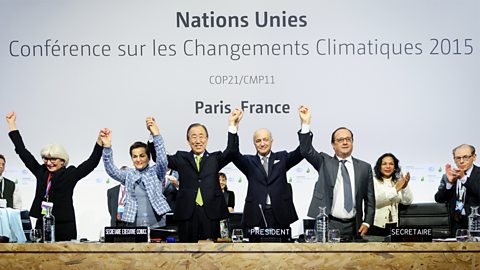Waste hierarchy
The waste hierarchyThis is a method used to rank waste management options in order of what is best for the environment. ranks all of the different waste management options into an order of what is best for the environment.
At the top of the pyramid is a reminder that the best way to manage waste is to prevent it from being created in the first place.
If waste is created, then the hierarchy makes a priority for re-use, recycling, recovery and then finally disposal.
'Reduce, reuse and recycle'
The idea of reduce, reuse and recycle is one that forms part of the waste hierarchy and has helped people to think about the environmental impact that they have.
There will also be a reduction in the amount of waste that ends up in the council-run landfill sites.
The image below shows that preventing waste in the first place is the most favourable option. Where this is not possible, then re-using products or recyclingReusing materials or reprocessing waste materials to produce new materials. is better for the environment than disposal in a landfill.
Reduce
This is when people purchase less вҖҳstuffвҖҷ so that it reduces the amount of energy required to manufacture and transport goods.
Initiatives are introduced to encourage people to turn lights off, share lifts and take shorter showers in order to reduce energy.
Some campaigns have also focused on ensuring that people reduce the amount of waste that they produce, for example food waste.
Reuse
This occurs as people use different materials again but do not convert them into different products.
People might reuse food containers and bottles instead of throwing them out or use travel coffee mugs instead of single-use cups.
In recent years in Northern Ireland, one major success in this area has been different initiatives to encourage people to reuse their shopping bags.
вҖҳBags for LifeвҖҷ and more robust plastic shopping bags have largely replaced single-use supermarket shopping bags.
Recycle
When waste materials are collected and separated out into their different component ingredients, these can then be remade into different products.
Some campaigns have focused on ensuring that our waste is correctly sorted into different bins e.g. not putting food waste into general waste bins but into organic waste bins.
Energy is required to recycle the product and to change its physical properties into something totally different.
For example, the plastic from bottles might be made into public benches or fleece jackets.
Sustainability
Sustainable use of resources
The world's natural resources have conflicting demands upon them and can be difficult to manage.
Aims of sustainability
The environment should be preserved.
Resources need to be retained for future generations to enjoy.
Humans need to continue to make and do the things that allow them to live comfortably.
LEDCLess Economically Developed Country вҖ“ usually a poorer country found in South America, Africa or Asia. need to develop through exploiting their resources.
There should be a better balance between the consumption of those resources between LEDCs and MEDCMore Economically Developed Country вҖ“ usually a rich country found in Western Europe or North America..
To conserve natural resources for future generations, sustainable managementMeeting the needs of people now and in the future and limiting harm to the environment. of the natural environment is necessary.
Alternative resources might be developed in order to ease the strain on finite resourceResource that can only be used once and is in limited supply. For example, oil is a finite resource..
However, alternative resources can be expensive and take time to develop.
Existing resources could be used more efficiently, to prevent finite resources being used up so quickly.
Renewable energy
Wind Power

Wind power has become one of the most popular renewable energy sourceA renewable resource is one which is naturally replaced and can be used repeatedly. in the UK as it is very cost effective.
It generated almost 30% of British electricity in 2023 and, since 2016, has produced more energy than coal.
The UK is the 6th largest producer of wind power and, by 2023, had over 11,000 turbines.
In the first three months of 2023, wind generated one third of total energy in the UK, overtaking natural gas for the first time.
- Wind power generation increased by 715% between 2009 and 2020
- 2020 has been the greenest year on record for the UK, so far.
The worldвҖҷs largest offshore windfarm, Hornsea 1, is off the coast of Yorkshire.

Advantages and disadvantages of wind power
Advantages of wind farms
Reduced carbon emissions: In recent years, much of the UK energy has come from the burning of fossil fuels. Burning fossil fuels to make electricity is declining, and wind farms are replacing those power stations. This reduces carbon emissions and will reduce the impact of the greenhouse effectThe trapping of the sunвҖҷs heat in the earthвҖҷs atmosphere by gases such as methane, carbon dioxide and water vapour. An increased greenhouse effect can lead to climate change..
Sustainable energy: Modern wind turbines are very good at converting wind to electricity. They are also reliable, lasting for up to 25 years. The UK, at the surrounded by seas and oceans, is better located for wind energyWind power is a renewable energy that is created using the forces of the wind to turn the sails on a turbine to generate power. than any other European country .
Less dependence on fossil fuelNatural, finite fuel formed from the remains of living organisms, eg oil, coal and natural gas.:The UK has depended on other countries for their fuel and this leaves us vulnerable to world events. There is not enough oil from local sources to meet our demands, so we need renewables to generate our electricity.
Value for money: Although making electricity using wind power had been viewed as more expensive than using oil or gas, by 2025 onshore wind is forecast to be the cheapest way to make electricity.
Disadvantages of wind farms
Visual pollution: Some people find wind farms to be an eyesore and will have an impact on tourism. As a response, in England onshore new wind farms have effectively been banned since 2015 although this policy now seems to be changing.
High set up costs: Wind farm projects are very expensive to set up. Walney 1 in Cumbria cost over ВЈ1 billion to set up. While, the wind farm did move to full production very quickly, it will still take around 20 years for the investment to break even. The costs of decommissioning wind farms will also be high.
The need for a backup: One of the most important (and worrying) issues about wind farms is that there are days when the wind speed is either too low and does not turn the sails of the turbines round or the wind speed is too high and the sails have to be secured for safety (over 26 knot winds). This means that there will be times when no energy is produced and an alternative source of energy will need to be brought online. Wind energy in the UK is more reliable in the winter daytime (44%) whilst it is weakest in the summer nights (13%).
Wildlife issues: Wind turbines can affect wildlife when being built, by collisions as well as through noise pollution. Bats are particularly vulnerable to collisions, and offshore wind turbines have been blamed for an impact on marine life, especially by noise pollution.
Is wind power a useful power source or not?
All sources of power have advantages and disadvantages. WindвҖҷs main disadvantage is that it is not generated all the time. It also affects wildlife, although those effects can be reduced. Its main advantage is that this is renewable energy with reduced impact on climate change. It also reduces dependence on imported fossil fuels. All this may explain why wind is used for generating more and more of the UK's electricity.
2015 International Climate Agreement
In 2015 the International Climate Change Agreement or the вҖҳParis AgreementвҖҷ was signed as a special agreement within the United Nations Framework Convention on Climate Change (UNFCCC).

The agreement dealt mostly with greenhouse gases, emissions mitigation, finance arrangements and adaption and would come into place in 2020.
The Agreement was negotiated by 196 parties and was agreed on 12 December 2015.
Main aims:
To strengthen the global response to threats caused by climate change.
To aim to keep the global temperature rise below 2 degrees C but ideally less than 1.5 degrees.
To strengthen the ability of countries to deal with the impacts of climate change.
To put in place appropriate financial flows and new technology frameworks that would help to support developing and vulnerable countries (mitigation and adaption).

Positives of the Paris Agreement
First time that all governments have agreed to try to limit global warming.
First time that governments around the world have agreed to aim to achieve net zero emissions in the second half of this century.
The aim to limit global warming to вҖҳwell below 2 degrees and striving for 1.5В°CвҖҷ is a stretch that has never been seen before and shows that countries are trying to reduce the impact of global warming around the world.
Some countries (like France) have taken immediate action and have stated an intent to ban all petrol and diesel engine cars by 2040.
Governments have agreed to review all of their climate commitments every 5 years.
Many of the worldвҖҷs biggest polluters agreed to make big reductions in their emissions. China who have produced 24% of all world carbon have promised to reduce emissions by 60% from 2005 levels. The EU have also pledged a 40% reduction in domestic emissions by 2030 compared to 1990 levels. This is a really ambitious target but many of the EU countries are well on their way to achieving this.
Negatives of the Paris Agreement
The Paris Agreement follows 36 years of climate meetings where very little progress was made. Since the 1990 Kyoto climate meeting вҖ“ global emissions have increased by 67%.
The Paris Agreement is non-binding вҖ“ this means that there are no consequences for any country that fails to achieve the agreed targets.
Many environmental organisations (like Greenpeace) find the 1.5В°C to 2.0В°C global warming limit as вҖҳdelusionalвҖҷ. They argue that the world is already two-thirds of the way towards that target and increasing at over 2% each year.
Kevin Anderson from the Tyndall Centre for Climate Change research has noted that, вҖҳthe combined pledges in the agreement will results in a 4-6В°C temperature increase, a 40-50% decline in agriculture, more droughts and violent storms, sea rise and flooding.вҖҷ
The pledges did not come into effect until 2020 вҖ“ so the nations committed themselves to 5 years of doing nothing.
Some economists have argued that the Paris conference really was just a signal that the fossil fuel era was coming to an end and that the era of renewable energy was just beginning.
Renowned climate change scientist James Hansen has noted, вҖҳItвҖҷs just worthless. There is no action, just promises. As long as fossil fuels appear to be the cheapest fuels out there, they will continue to be burned.вҖҷ
In September 2023 countries met to assess progress. They concluded that the agreement has had a significant effect. In 2010 it had been expected that global temperatures would rise by between 3.7 and 4.8В° Celsius by 2100 but work by governments around the world limited that to around 2.5В°C. If all countries meet their promised targets, the rise might be limited to between 1.7 and 2.1В°C.
However, that is still much more than the required 1.5В°C target and global emissions are still rising.
More on Managing our environment
Find out more by working through a topic
- count3 of 3

- count1 of 3
